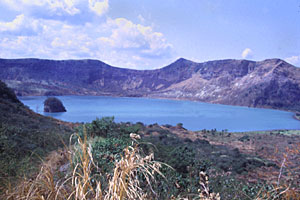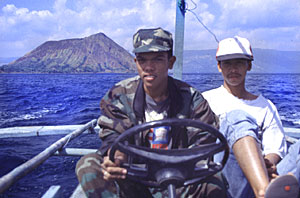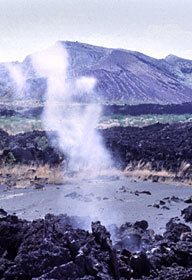Inside the Volcano
In the Philippines, there is a crater containing a lake. In the lake is an island, topped by another mountain, which also has a crater that contains yet another lake. In the midst of its warm waters is another island. And here stands Taal, one of the world's smallest, but most dangerous volcanoes.
By Ron Gluckman / Taal, the Philippines
K
INKO'S EYES ARE BULGING. HIS HAIR STANDS ON END. His skin turns red and actually seems to smoulder. Somehow, Kinko has turned into a volcano, smoking at my incendiary suggestion. "Crazee," he says, terror pouring from his every pore."Drive," I command. And Kinko did, all the way from Manila to Tagatay City, two hours south of Manila, where we stop for sustenance at an appropriately unique hotel restaurant.
Out back was a huge telescope. Five pesos (less than 20 US cents) bought a token that would bring into focus views of a world wonder - the smallest smoking volcano on the planet.
Well, it would have, if conditions were right. Taal Volcano was cooperating, huffing and puffing so much that seismologists had sealed the entire area to visitors and evacuated residents. We could see the deadly volcano in the distance, a tiny fountain of flame. However, this being the Philippines, since the telescope seemed to be working, naturally nobody working the grounds had any tokens.
"This is a very popular place for Filipinos," my guide said of the Taal Volcano lookout hotel. "Especially honeymooners."
Squinting at the smoke-stained panorama, I tried to imagine a hot courtship consummated in such sizzling surroundings. Torrid thoughts were torn away when guide Lina Jose explained that lovers didn't come here for the heat. Far from it. This mountain area's main attribute was its cool climate, offering respite from Manila, which is hotter than a pizza oven for most of the year.
The irony was irresistible. Manila's middle and upper classes used to migrate in summer to Baguio, until that mountain retreat was destroyed by an earthquake. Now they flocked to this volcano lodge, apparently safe from the eminent eruption atop a nearby mountain, which was, in fact, the rim of a larger volcanic crater that had long ago collapsed in volcanic convulsions.
 To this ancient ledge I had come, to peer down the sides into the
depths of the crater. In its bottom was a lake. And across the lake was an island, the
aptly named Volcano Island. Here sits Taal, the world's smallest, but among the deadliest
volcanoes.
To this ancient ledge I had come, to peer down the sides into the
depths of the crater. In its bottom was a lake. And across the lake was an island, the
aptly named Volcano Island. Here sits Taal, the world's smallest, but among the deadliest
volcanoes.
In the center of Taal's tiny crater, across the vast lake, could be spied the beckoning blue waters of yet another lake. And, in its center, far in the distance, was another island.
The entire scenario was evocative and enigmatic, like an intricate Chinese puzzle. Only intensely more perilous.
Piercing the puzzle was the purpose of my trip. I left Manila before dawn to arrive at Taal in the morning haze. Already, the volcano was awake, spewing smoke and lava foam. Even the ground was active, shaking with several earthquakes every hour. Taal's fierce fires drew me closer like the frantic caress of a lover.
Of course, Kinko clearly had other ideas. Lunch at the hotel overlooking the Taal terrain seemed as close as he wanted to get to the volcanic lake, where residents had been removed from the rocking and rolling island, because an eruption seemed eminent. Taal has a history of tragic eruptions. In 1911, for instance, light from the firestorm could be seen all the way to Manila.
Yet over a thousand people live on the island, scratching a living from the lava rock and thin soil. In olden times, they were all wiped out whenever the volcano blew. Now, with advance warning, the toll is generally limited to few hundred, plus a hundred more from the villages that line the shores Lake Taal, surrounding the volcano, inside the larger crater.
It was to these very villages that I was proposing to go against Kinko's adamant protests.
My plan was to reach one of the larger towns to try and hire a boat to continue to the volcano island itself. Although the entire area was officially off limits at the time, I was pretty confident I could find a way to climb Taal and take some pictures of the turquoise lake inside the crater.
Kinko wasn't keen on the first part of the plan. And he was too terrified to consider the subsequent intentions. Speaking little English, he held his breath so his cheeks puffed up, then ran his hands over his head to simulate an eruption and ended by running a finger across his throat. I pointed out that I was paying for the car and still had plenty of money left in my wallet. Minutes later, we were winding down the mountain roads, the volcanic island looming larger through the palm trees.
We were heading to Tallisay, a lakeside village that had relocated many times in the past. How many times is hard to say. Records are even hazier than the air over the volatile volcano. When Taal acts up, the lake waters are heated and swell, swamping various settlements. The little village of Lipa, for instance, moved at least five times in a 100-year span. Divers have sighted old church towers in the lake.
"You probably won't be able to go to the island," advised Jose, in a motherly manner. As an employee of the Department of Tourist, she was working for the same government that had issued the alert putting the island and lakeshore off limits. Yet, in the friendly style of Filipinos, she didn't mention this other than to underscore the difficulty that might follow when I tried to hire a boat and guides, as if she was more concerned about my potential disappointment than the danger, let alone her official duties.
As it turned out, money talked and we walked, or boated. A sturdy village outrigger was rented at a premium. Jose stayed behind with a good book, as four of us set out, two young guides, myself and... Kinko! That's right, the same driver who shivered with fear at the prospect of approaching the lake, was now enthusiastically crossing it. Jose noticed my shock at seeing Kinko leap aboard and explained, "He's never seen the volcano."
Water spilled into the boat as it crashed into the waves of the lake. The depth is unmeasurable, the water pure. At the helm was Irwin, dressed for battle in army camouflage coat and khaki pants. Rolando was also along for the ride, wearing a T-shirt printed with a newspaper page.
 Irwin and Rolando, both 24, said they have each visited the volcano
island a hundred times. At least, those seem to be the numbers suggested. Communication
was limited, since the only English on board besides my own was upon the tattered
confederate flag that waved in the breeze, occasionally displaying the message: "I
(heart) America."
Irwin and Rolando, both 24, said they have each visited the volcano
island a hundred times. At least, those seem to be the numbers suggested. Communication
was limited, since the only English on board besides my own was upon the tattered
confederate flag that waved in the breeze, occasionally displaying the message: "I
(heart) America."
Huts were visible as we skirted the shore. Most residents of the island subsist by fishing and farming. In the poorest reaches of the Philippines, where feudal barons still hold lease on enormous estates, volcanoes can be the most expedient form of land reform. On the Taal island, nearly everyone dies when the volcano blows. Within a few weeks, the population is back to normal levels, as new residents are willing to bet their lives on this land lottery and the unlikelihood of another eruption.
Not that it's a particularly good bet. Taal has blown its top 41 times in recorded history. The 1911 eruption killed at least 1,300 people, and ash covered an estimated 2,000 acres. During the eruption of 1965, an early warning system kept the death toll to 200, and farmers were back in the fields within a few days. Still, Taal tends to be a terrible wager, with seismic activity pretty constant throughout this century.
And the land offers a bleak bounty for those willing to buck the odds. The soil is dark and crusty. The crops are mostly kamote and cassava, cheap root varieties that yield a minimal return for the risk.
Still, the island has an unique allure of an almost mystical nature. The island appears to be a floating mountain, one huge pyramid of rock on a cushion of clouds. In reality, the island is really a series of distinct craters, a dozen in all.
We land and walk through lush green carpets of ferns by the shore, then into fields of scraggly, prickly stalks. The trail twists into thickets, then climbs crumbling rock to a hilltop. The sun is fierce and no water is available along the way.
After nearly an hour of hard climbing, we reach the top of the main crater, the smoldering center of concern. Every bead of sweat is worth this first breathtaking view. Deep inside the crater is the volcanic lake, swollen from the simmering heat of the demons inside the Earth. Yet the lake itself seems sheepish, innocently removed from the often-deadly activity underneath its waters. The surface is smooth. The blue-green waters reflect the purplish-tinted hilltops and puffy clouds overhead.
Kinko, Rolando and Irwin collapse in the shade of some trees, while I snap dozens of photos of the magical scene. I'm startled at one point by movement in the bushes. Out walks a man loaded with equipment, a seismologist who has just taken a measurement of the lake temperature, one way of gauging an eminent eruption.
"We've had 10 earthquakes over the last 24 hours," he says. "They've all been light. The lake is still high and hotter than usual, but it seems to be settling down."
Then, he wanders off, without even a word of warning to the
camera-crazy tourist who is violating the government ban on visiting this violent volcano.
Gathering my guides, we continue onto the other active crater. Along the way, we walk through lava fields, twisted and tortured formations of black rock obscured by the steam surging from the ground. The terrain is barren, the earth reduced to a dry grey ash that makes everything dirty within minutes.
Tumbling over the lava formations, I stop to shoot a few photos of Kinko for his family, than continue to the source of the steam. Rolando and Irwin are yelling, but I fail to heed their warnings until the heat surges through my tennis shoes. When lifted, the soles dissolve in webs of melted rubber, the ends of which are glued to the ground.
Rolando and Irwin dissolve in laughter. Kinko seems uncertain whether to follow suit, but surrenders to the silliness at the sight of my consenting smile. The giggles continue all the way back to the boat.
A few days later, the Taal volcano alert is lowered and the residents return. Life in the lake villages resumes. The air clears, the waters cool and the swollen belly of the lake slowly recedes, the peril of this pregnancy passes without loss.
Unless one counts my molten tennis shoes, precious souvenirs of a titillating brush with mortality on the rim of Taal's tiny cone of death and danger.
Ron Gluckman is an American journalist based in Hong Kong, who travels widely around the Asian region for a variety of publications, including Sawasdee, which ran this story in 1992. It was widely reprinted. Taal has blown it's top many times since.
For other stories by Ron Gluckman from the Philippines, turn to Waterworld or Revolutionary with Room Service
To return to the opening page and index
push here
[right.htm]
